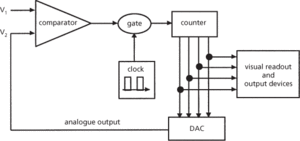Electronic hardware used in the control of processes that converts analogue signals such as electrical voltage, current, temperature, and pressure into digital data that a computer can process.
See A/D converter.
A device/circuit/IC that converts a continuous analogue signal into a discrete binary signal. There are many forms of ADC, including continuous balance converters, voltage-to-frequency converters, and dual ramp or integrating converters. A simple continuous balance converter is shown in the diagram. The counter is initially set to zero so that signal V2 from the digital-to-analogue converter (DAC) section of the circuit is zero. When the unknown input V1 is greater than V2, the comparator provides an output voltage that opens the gate and allows pulses to be applied to the counter. So long as the gate remains open, clock pulses are fed to the counter and V2 continues to increase. When V2 equals V1, the comparator output falls to zero and closes the gate. This ‘freezes’ the number stored in the counter, which can then be displayed on a digital readout device. In practical forms of the device, the counter is one that can count ‘up’ and ‘down’ to allow changes in V1 to be followed.

4-bit analogue-to-digital converter
- ferrohastingsite
- ferroics
- ferromagnesian minerals
- ferromagnetic
- ferromagnetism
- ferropericlase
- ferrosilite
- ferrosoferric oxide
- ferrous compounds
- ferruginous
- Ferry, Jules François Camille (1832–93)
- Fertile Crescent
- fertile material
- fertility
- fertility, soil
- fertilization
- fertilizer
- Ferungulata
- Feshbach resonance
- Fessenden, Reginald Aubrey (1866–1932)
- Festiniogian
- FET
- fetal membranes
- fetch
- fetch-execute cycle